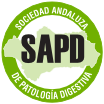Buscar en la RAPD Online

VOL 39
N6 Noviembre - Diciembre 2016
N6 November - December 2016
Datos de la publicación
Lesiones por ingesta de cáusticos: análisis de los casos en el Área Sanitaria Costa del Sol.
Injuries due to caustic ingestion: analysis of cases at the Costa del Sol Hospital.
Resumen
Introducción: la ingesta de cáusticos constituye una urgencia médica que puede producir un gran espectro de lesiones. La endoscopia permite conocer la extensión y gravedad de las lesiones, siendo la clasificación de Zargar de valor pronóstico.
Objetivo: Describir los resultados de la endoscopia digestiva alta (EDA) con carácter urgente en pacientes con ingesta de cáusticos en nuestro medio, así como el seguimiento y evolución clínica.
Material y métodos: estudio descriptivo retrospectivo de los pacientes sometidos a EDA urgente por ingesta de cáusticos entre enero 2010 y mayo 2015 en el Hospital Costa del Sol. Se tienen en cuenta variables demográficas, analizando la intención de la ingesta, el tipo de producto ingerido y la evolución en función del grado lesivo.
Resultados: Se realiza una EDA de urgencia por sospecha de ingesta de cáustico en 43 pacientes en el periodo de estudio, con una media de edad de 45,91 años. El 39% presentó lesiones. El 58,1% de los pacientes ingirió el cáustico accidentalmente, el resto lo hizo con fin autolítico. El 64,7% de los pacientes con lesiones precisó ingreso, con una estancia media hospitalaria de 5,59 días. Todos los pacientes con lesión grave requirieron ingreso hospitalario, precisando éstos mayor duración de ingreso y necesidad de uso de antibióticos y corticoides. No se han encontrado diferencias estadísticamente significativas entre el grado de lesión y el tipo de producto ingerido ni la intención de la ingesta.
Conclusiones: La endoscopia digestiva es la prueba diagnóstica fundamental en los casos de ingestión de estos agentes corrosivos. A mayor gravedad de las lesiones en la endoscopia inicial los pacientes presentan peor curso clínico.
Palabras clave: Ingestión de cáusticos, clasificación de Zargar, estenosis cáustica, endoscopia.
Abstract
Introduction: Caustic ingestion is a medical emergency that can cause a large spectrum of injuries. Endoscopy allows to know the extent and severity of these injuries, being Zargar's grading classification of prognostic value.
Aim: Describing the results of the urgent upper gastrointestinal endoscopy in patients with caustic ingestion in our region, as well as their follow-up and clinical outcome.
Material and methods: Retrospective study of patients that underwent an urgent upper gastrointestinal endoscopy caused by caustic ingestion between January 2010 and May 2015 at the Hospital Costa del Sol including demographic variables. We analyzed the intention of the intake, the type of product ingested and the evolution in relation to the harmful degree.
Results: An upper gastrointestinal endoscopy was performed due to suspected caustic ingestion in 43 patients whose mean age was 45,91 during the study period. 39% had some injuries. 58,1% of the patients ingested the caustic by accident; the rest did it with an autolytic purpose. 64,7% of patients with lesions required admission, with a mean hospital stay of 5,59 days. All patients with severe injuries required admission needing a longer stay and use of antibiotics and steroids. No significant statistically differences were found between the degree of injuries and the type of product ingested or the intention of the intake.
Conclusions: upper gastrointestinal endoscopy is the gold standard test in cases of ingestion of these corrosive agents. Patients with more severe lesions in the first endoscopy had a worse clinical course.
Keywords: Caustic ingestion, Zargar's grading classification, caustic stricture, endoscopy.
